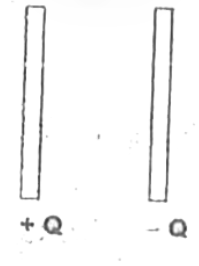Two plates of a charged parallel plate capacitor are pulled apart with the help of insulating handles, till their separation is doubled.
Compare the new electrostatic potential energy of the capacitor with the old
To solve the problem of comparing the electrostatic potential energy of a charged parallel plate capacitor before and after the plates are pulled apart, we will follow these steps:
Step 1: Understand the initial conditions
Let the initial separation between the plates be d and the charge on the plates be Q. The capacitance C1 of the capacitor can be expressed as:
C1=ε0Ad
where ε0 is the permittivity of free space and A is the area of the plates.
Step 2: Calculate initial electrostatic potential energy
The electrostatic potential energy U of the capacitor can be calculated using the formula:
U=Q22C
Substituting C1 into the equation, we get:
U=Q22C1=Q22(ε0Ad)=Q2d2ε0A
Step 3: Understand the new conditions after separation is doubled
Now, the plates are pulled apart so that the new separation is 2d. The new capacitance C2 can be expressed as:
C2=ε0A2d
Step 4: Calculate new electrostatic potential energy
The new electrostatic potential energy U′ can be calculated as:
U′=Q22C2=Q22(ε0A2d)=Q2⋅2d2ε0A=Q2dε0A
Step 5: Compare the two energies
Now, we can compare U′ with U:
U′=2(Q2d2ε0A)=2U
This shows that the new electrostatic potential energy U′ is twice the initial electrostatic potential energy U.
Conclusion
Thus, the new electrostatic potential energy of the capacitor after the plates are pulled apart is double the original potential energy.
Let the initial separation between the plates be d and the charge on the plates be Q. The capacitance C1 of the capacitor can be expressed as:
C1=ε0Ad
where ε0 is the permittivity of free space and A is the area of the plates.
The electrostatic potential energy U of the capacitor can be calculated using the formula:
U=Q22C
Substituting C1 into the equation, we get:
U=Q22C1=Q22(ε0Ad)=Q2d2ε0A
Now, the plates are pulled apart so that the new separation is 2d. The new capacitance C2 can be expressed as:
C2=ε0A2d
The new electrostatic potential energy U′ can be calculated as:
U′=Q22C2=Q22(ε0A2d)=Q2⋅2d2ε0A=Q2dε0A
Now, we can compare U′ with U:
U′=2(Q2d2ε0A)=2U
This shows that the new electrostatic potential energy U′ is twice the initial electrostatic potential energy U.
Thus, the new electrostatic potential energy of the capacitor after the plates are pulled apart is double the original potential energy.
Topper's Solved these Questions
- SAMPLE PAPER 2022BOOK - ICSE MODEL PAPERCHAPTER - SAMPLE PAPER 2022EXERCISE - PART II (SECTION B)
8 Videos
- SAMPLE PAPER 2022BOOK - ICSE MODEL PAPERCHAPTER - SAMPLE PAPER 2022EXERCISE - PART II (SECTION C)
8 Videos
- SAMPLE PAPER 2022BOOK - ICSE MODEL PAPERCHAPTER - SAMPLE PAPER 2022EXERCISE - PART I (Question)
15 Videos
Similar Questions
A parallel plate capacitor is charged. If the plates are pulled apart
View SolutionThe plates of a parallel plate capacitor are pulled apart with a velocity v. If at any instant their mutual distance of separation is x, then magnitude of rate of change of capacitance with respect to time varies as
View Solution
Knowledge Check
A parallel plate capacitor is charged and then isolated. The effect of increasing the plate separation on charge, potential and capacitance respectively are
Aconstant, decrease, decreaseBincrease, decreases, decreasesCconstant, decreases, increasesDconstant, increases, decreases.
The plates of a parallel plate capacitor are not exactly parallel. The surface charge density is therefore,
View SolutionConsider a parallel plate capacitor having charge Q. Then,

View SolutionA parallel plate capacitor is connected to a battery. The plates are pulled apart with uniform speed. If x is the separation between the plates, then the rate of change of electrostatic energy of the capacitor is proportional to
View SolutionA parallel plate capacitor is charged and then isolated. On increasing the plate separation
View SolutionFind out the capacitance of parallel plate capacitor of plate area A and plate separation d.
View SolutionA parallel plate capacitor is charged and then isolated. The effect of increasing the plate separation on charge, potential and capacitance respectively are
View SolutionThe separation between the plates of a charged parallel-plate capacitor is increased. The force between the plates
View Solution
